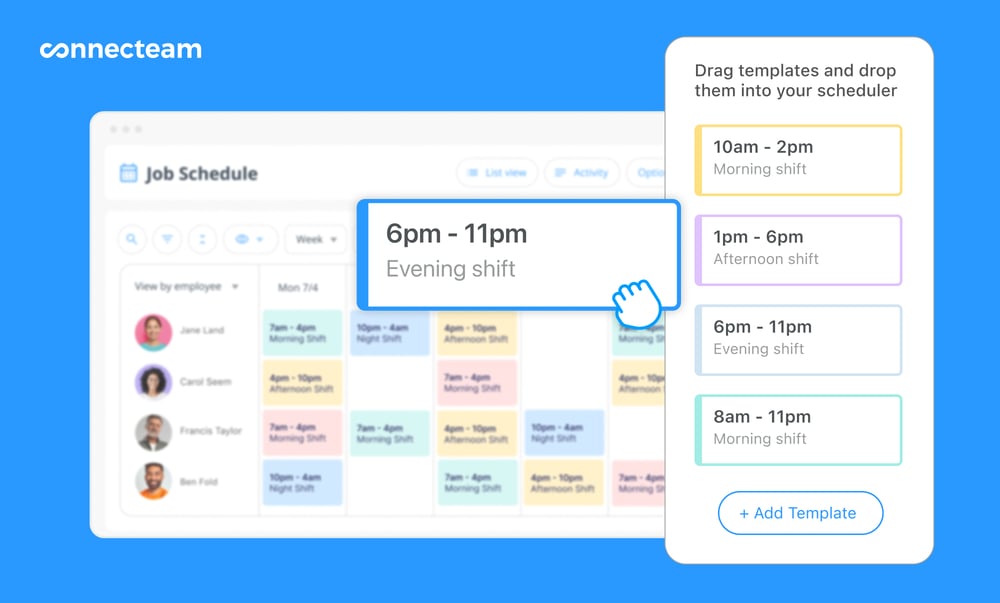The 5/40 work schedule is the most commonly used schedule, in which employees work 8-hour shifts 5 days per week. We help you decide if it’s right for your business and look at popular variations.
A 5/40 schedule is the most commonly used work schedule in the US. It requires employees to work 8-hour shifts 5 days a week—for a total of 40 hours per week.
However, just because the 5/40 schedule is popular doesn’t mean it’s the best fit for every business.
In this guide, we explain how the 5/40 schedule works, discuss its advantages and drawbacks, and share some alternative work schedules.
Key Takeaways
- The 5/40 work schedule requires employees to work five 8-hour days in a row, followed by two days off.
- A 5/40 work schedule matches norms in the US and offers some support for work-life balance. However, it isn’t good for maximizing productivity and offers little flexibility.
- Alternatives to the standard 5/40 schedule include compressed, 5-4/9, and flexible schedules. These schedules can boost productivity and enable employees to establish better work-life balance.
What Is a 5/40 Work Schedule?
In a 5/40 work schedule, employees are required to work 8 hours a day, 5 days in a row, followed by 2 days off. Employees work 40 hours per week and always work the same days each week.
The 5/40 schedule is the most commonly used schedule in the US, especially for office workers. An example of a 5/40 work schedule is someone working 9am-5pm, Monday through Friday.

History of the 5/40 Work Schedule
The history of the 5/40 work schedule dates back to 1926 when Henry Ford instituted it across his automobile factories.
Ford found that limiting employees to 40 hours per week increased productivity, and other manufacturers soon followed his example.
In 1940, the 40-hour work week was codified in the US through the Fair Labor Standard Act.
Under the law, employees who worked more than 40 hours per week would have to be paid overtime. This incentivized employers to organize work around a 5/40 schedule.
Though the 5/40 work schedule has become the standard in the US, there have been efforts to challenge it.
A growing number of companies have experimented with 4-day work weeks and other alternative work schedules that give employees more flexibility.
Pros and Cons of the 5/40 Schedule
There are both advantages and disadvantages to using a 5/40 schedule.
Pros
- Benefits for employees’ personal schedules: Since most businesses use a 5/40 schedule, employees’ schedules will be aligned with those of their friends and family when they’re off work. In addition, employees always work the same days each week, so they can plan their personal calendars far in advance.
- 5-day weeks meet customer expectations: Most customers expect businesses to be open 5 days a week, and the 5/40 schedule caters to this.
- Can help avoid stress: Though some studies show shorter work weeks can lower stress, others have shown that reducing employees’ hours can sometimes increase stress as workers rush to finish their tasks. The 5/40 schedule gives employees more hours per week and, thus, more time to complete their work.
- Lowers management costs: Since the 5/40 schedule is so commonly used, it’s easy to manage without complex or custom scheduling solutions.
- Minimizes overtime pay: Employees are scheduled for only 40 hours a week of work in a 5/40 schedule, so you typically won’t have to pay overtime. It’s also easy to monitor when employees are working overtime and require them to stick to 8 hours a day to limit overtime expenses.
Cons
- 8-hour days aren’t good for productivity: Research has shown that the best number of hours to work for maximizing productivity is no more than 6. In an 8-hour day, employees could be working unproductively for several hours every day.
- Can contribute to employee burnout: Many employees find that a 2-day weekend isn’t enough time to rest and recover between work weeks. This can lead to increased employee burnout.
- Not flexible to meet variable demand: 8-hour work days are relatively inflexible. Employees may have a lot of work one day and little the next, but they still need to work 8 hours each day—leading to one stressful day and then a day with wasted time.
Variations on the 5/40 Schedule
Many variations on the 5/40 schedule have been developed to give employees more flexibility and increase productivity. Let’s examine some of the most common variations below.
Compressed schedules
In a compressed schedule, employees work 40 hours per week in fewer than 5 days. Usually, compressed schedules involve 4 10-hour days. This gives employees 3 days between work, which can help boost work-life balance and reduce burnout.
Pro Tip
If you plan to implement a compressed schedule, ensure your employees aren’t overly stressed by 10-hour work days. When employees push themselves too hard during the week, it can offset the benefits of having an extra day off and lead to higher rates of burnout.
5-4/9 schedules
A 5-4/9 schedule can be less stressful for employees than a compressed schedule. In a 5-4/9 schedule, employees work 9-hour days instead of 8-hour days.
They’ll work 5 days one week followed by 4 days the next, for a total of 80 hours worked every 2 weeks.
Basically, employees work the same amount as in a standard 5/40 schedule but get an extra day off every other week.
Flexible work schedules
While a standardized schedule requires employees to show up for work at the same time every day, a flexible 5/40 schedule doesn’t.
Employees can choose when to work as long as they work 8 hours per day or 40 hours per week.
Flexible work schedules give employees more autonomy and can improve work-life balance. However, not having all employees at work at the same time can stifle innovation and increase social isolation at work.
Some businesses solve this by requiring employees to work several core hours each day, then giving them the flexibility to determine the rest of their daily schedule.
Pro Tip
You might try a flexible work schedule for a month to see if it’s right for your business. Workforce management software like Connecteam makes implementing this schedule easy! You can use Connecteam’s AI scheduler to instantly assign open shifts based on employee availability, preferences, and qualifications.
You can also share surveys to measure employees’ work satisfaction before and after you trial the new schedule.

Conclusion
The 5/40 schedule is the most commonly used work schedule in the US. Employees work 5 consecutive 8-hour days for a total of 40 hours per week.
The 5/40 schedule is easy to fit personal commitments around and might help reduce stress, but it isn’t good for employee productivity.
Variations such as compressed schedules and 5-4/9 schedules can offer more flexibility.
Whether your business needs a standard 5/40 schedule or a variation, Connecteam can help.
Try Connecteam free today to start scheduling your employees and maximize your business’s productivity.


